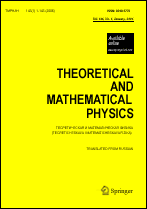|
This article is cited in 28 scientific papers (total in 28 papers)
Influence of the quark–gluon string fusion mechanism on long-range rapidity correlations and fluctuations
E. V. Andronov
St. Petersburg State University, St. Petersburg, Russia
Abstract:
Multiparticle production in soft hadronic interactions can be successfully described in the framework of the color-string approach, which will probably be derived from the first principles of chromodynamics in the future. A fundamental property of this approach is the translation invariance of the rapidity spectrum of charged particles produced by one source at high energies. This symmetry results in the appearance of long-range rapidity correlations through event-by-event fluctuations of the number and/or type of strings. We describe the behavior of correlations between multiplicities ($n$–$n$) and between the transverse momentum and multiplicities ($p_{\mathrm t}$–$n$) of charged particles with the mechanism of forming sources of two types taken into account. We obtain an exact analytic expression for the $(n$–$n)$-correlation coefficient. Because no exact solution can be obtained for the ($p_{\mathrm t}$–$n$)-correlation coefficient, we propose an effective approximation that significantly simplifies numerical computations. We verify all these results by direct simulation using the Monte Carlo method. We also investigate how the fusion mechanism influences the behavior of strongly intensive variables characterizing the multiplicity fluctuations in two rapidity windows.
Keywords:
long-range correlation, strongly intensive variable, quark–gluon string.
Citation:
E. V. Andronov, “Influence of the quark–gluon string fusion mechanism on long-range rapidity correlations and fluctuations”, TMF, 185:1 (2015), 28–36; Theoret. and Math. Phys., 185:1 (2015), 1383–1390
Linking options:
https://www.mathnet.ru/eng/tmf8931https://doi.org/10.4213/tmf8931 https://www.mathnet.ru/eng/tmf/v185/i1/p28
|


| Statistics & downloads: |
| Abstract page: | 312 | | Full-text PDF : | 147 | | References: | 72 | | First page: | 14 |
|




 Contact us:
Contact us: Terms of Use
Terms of Use
 Registration to the website
Registration to the website Logotypes
Logotypes








 Citation in format
Citation in format 
